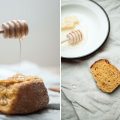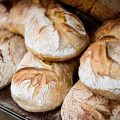Sourdough bread has come so far, especially with all these creative recipes that seem to have sourdough lovers in a chokehold. I’m here to add to these recipes with an easy sourdough ciabatta bread recipe!
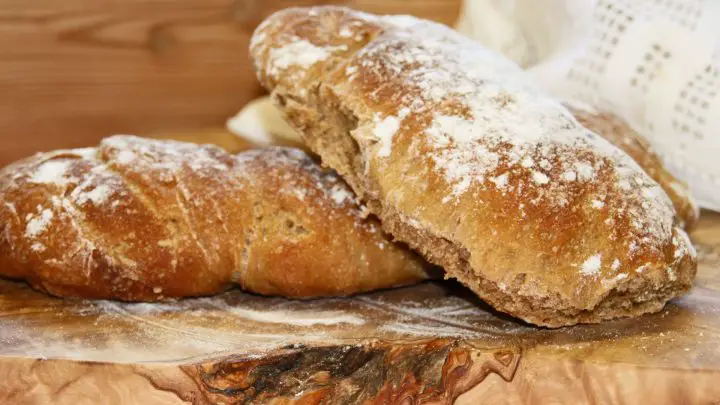
Table of Contents
- What is Ciabatta Sourdough?
- What Is The Difference Between Sourdough and Ciabatta?
- Best Flour For Sourdough Ciabatta
- Sourdough Ciabatta Rolls Recipe
- Tips For The Best Sourdough Ciabatta
- How To Store Sourdough Ciabatta?
- What To Serve With Sourdough Ciabatta?
- Sourdough Ciabatta Recipe to Try Now
- FAQs
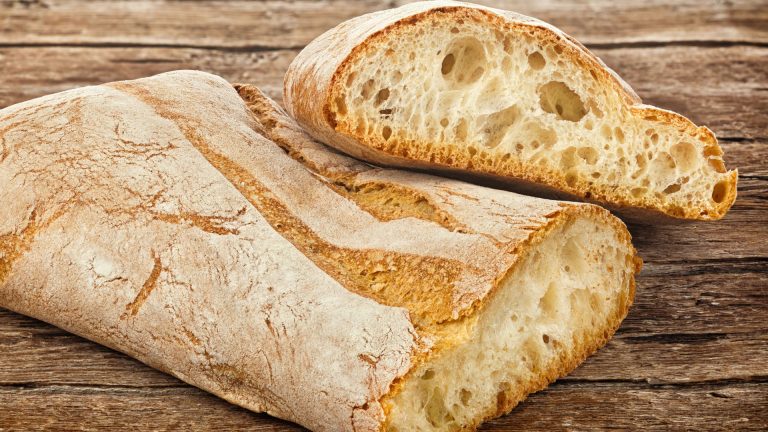
Easy Sourdough Ciabatta Bread Recipe
Ciabatta rolls make the perfect centerpiece of any dinner party, so imagine how amazing these sourdough ciabatta rolls will look and taste on your table.
- Total Time: 16 hrs 50 mins
- Yield: 6 rolls 1x
Ingredients
For the sourdough starter
- 35g of starter
- 35g of all-purpose flour
- 35g water
For the ciabatta dough
- 420g bread flour or strong all-purpose flour
- 340g water
- 13g extra virgin olive oil
- 9g salt
- All the sourdough starter
Instructions
- Feed your sourdough starter in the morning, and once it has doubled in volume it’s ready to use.
- In a large mixing bowl, combine flour and water and mix or knead until you’re left with a sticky shaggy dough. Let this rest for at least 30 minutes.
- Add olive oil, salt, and sourdough starter, mixing until everything is well combined. This should make a very wet and sticky dough, that may be a tad hard to handle. The best way to handle sticky dough is to wash your hands with cold water so that your hands remain cold enough for the dough. Transfer the sticky dough to a clean bowl, and let this sit for 15-20 minutes.
- Perform 6 sets of stretches and folds to shape the dough at 30-minute intervals.
- Use wet hands to take one side of the dough, and stretch it up and over itself. Then turn the bowl slightly and repeat.
- Let the dough rest for 30 minutes between each set. Cover the dough with a lid or damp towel to prevent the dough from drying out completely.
- After the stretch and fold, let the dough bulk ferment in a warm place for 3-5 hours, or until it has risen by at least 60%.
- The bulk fermentation time may change depending on the temperature. Once it has risen, cover the container with a lid or plastic wrap and place it in the fridge overnight.
- Tip the cold dough onto a lightly floured work surface. Meanwhile, line a baking sheet with a piece of parchment paper, and dust this with flour.
- Use floured hands to pull the dough into a rectangle. Flour the dough some more, and use a bench scraper to cut the sourdough ciabatta dough into 6 equal pieces.
- Use floured hands to pick up each piece of dough and transfer it to the baking tray. Repeat this process with the remaining pieces of dough. Try not to move the dough too much or you could risk degassing the dough.
- Let the pieces of ciabatta dough rest at room temperature for 50-60 minutes. Preheat the oven to 450 degrees Fahrenheit, while the dough rests.
- While the oven preheats, place a cast iron skillet at the bottom of the oven rack. This will help create steam while the bread bakes, with the addition of water.
- Shut the door immediately to trap the steam.
- Lightly spray the tops of the dough with water, and place a baking sheet in the preheated oven beside the water for steam.
- Bake the rolls for 20 minutes until they’re a deep golden brown.
- Once baked, let them cool down on a wire rack, before slicing and serving.
Notes
- For this sourdough bread recipe, you’re going to need high-hydration dough.
- Prep Time: 30 mins
- Cook Time: 10 mins
- Category: bread
- Cuisine: Italian
Nutrition
- Serving Size: 1 roll
- Calories: 293 kcal
- Fat: 3 g
- Carbohydrates: 55 g
- Protein: 9 g
What is Ciabatta Sourdough?
Sourdough ciabatta is an Italian bread made from wheat flour, bread flour, or high-protein all-purpose flour. With the addition of water, olive oil, salt, and a sourdough starter which is a type of natural yeast, that provides unique tangy flavors, and that wonderful sourdough rise we all know and love.
The phrase ciabatta means slipper in Italian, referring to the long, and flat-shaped bread.
Is Ciabatta Made of Sourdough?
Normally ciabatta dough is made with flour, olive oil, water, and a type of pre-fermented yeast. The only difference here is that ciabatta doesn’t require a long fermentation, unlike sourdough starter. While, this sourdough recipe will call for a mature sourdough starter to act as a leavening agent, and create that natural rise.
What Is The Difference Between Sourdough and Ciabatta?
The main difference between the two types of bread is the hydration levels.
Sourdough bread has a dense crumb structure due to its lower hydration. This results in a stiff dough, where the crumbs are a little closer together, rather than wide and open like ciabatta.
Additionally, ciabatta bread has a more flattened structure compared to sourdough tall one. It is also much lighter in texture compared to sourdough.
Much like sourdough bread ciabatta also uses natural yeasts. However, unlike sourdough starter which requires days or weeks to mature, the ciabatta yeast can be ready within the day. Although this type of fermented yeast will require the assistance of commercial yeast along with flour, salt, water, and additional ingredients like olive oil.
Different Taste of Ciabatta and Sourdough
There is a distinct difference in taste between the two types of bread. Sourdough is very much appreciated for its delicious tart and tangy flavors, which make it the perfect candidate for sandwiches or served plain with a glob of butter and a drizzle of olive oil. The flavors are enough to make every bite a special treat. Another great way to enjoy sourdough bread is to rip it up into tiny little chunks and toss it over some hot and spicy soup. The scrumptious flavors of the soup immediately seep into the softened bread, so that you can enjoy each delightful bite.
Ciabatta, however, has a very light and crusty texture compared to sourdough, with mildly sweet flavors that also taste amazing when paired with olive oil. You can also experiment with a variety of flavors to make the perfect crunchy ciabatta sandwich.
Best Flour For Sourdough Ciabatta
For a true ciabatta textured loaf, you must use high-protein bread flour. Try to use organic or unbleached bread flour as your sourdough starter may contain a different type of flour, especially if you’ve been using it in sourdough baking. You can also discard a small portion of the starter and feed it with some bread flour, although this might create an imbalance in the protein ratio, so don’t worry too much about the flour used for the starter.
What Type of Sourdough Starter To Use For Sourdough Ciabatta?
For this particular sourdough recipe, you’re going to need an active sourdough starter, as well as a highly hydrated starter. This means that your dough will very likely be incredibly sticky, and quite hard to handle. But this is essential for this sourdough recipe. Be sure to lavishly flour your work surface so that it becomes easier to shape and work with.
The high hydration is essential as it allows your dough to spread out more and into its signature slipper shape and open crumb. The best way to move your dough around would be with a dough scraper, or very cold hands so that the heat doesn’t tear the ciabatta dough.
Sourdough Ciabatta Rolls Recipe
Ciabatta rolls make the perfect centerpiece of any dinner party, so imagine how amazing these sourdough ciabatta rolls will look and taste on your table. For this sourdough bread recipe, you’re going to need high-hydration dough.
- Type: Bread
- Cuisine: Italian
- Recipe yield: 6 rolls
- Calories: 293kcal
- Preparation time: 30 minutes
- Cooking time: 20 minutes
- Additional time: 16 hours
- Total time: 16H50M
Ingredients
For the sourdough starter
- 35g of starter
- 35g of all-purpose flour
- 35g water
For the ciabatta dough
- 420g bread flour or strong all-purpose flour
- 340g water
- 13g extra virgin olive oil
- 9g salt
- All the sourdough starter
Instructions
Feed your sourdough starter in the morning, and once it has doubled in volume it’s ready to use.
- In a large mixing bowl, combine flour and water and mix or knead until you’re left with a sticky shaggy dough. Let this rest for at least 30 minutes.
- Add olive oil, salt, and sourdough starter, mixing until everything is well combined. This should make a very wet and sticky dough, that may be a tad hard to handle. The best way to handle sticky dough is to wash your hands with cold water so that your hands remain cold enough for the dough. Transfer the sticky dough to a clean bowl, and let this sit for 15-20 minutes.
- Perform 6 sets of stretches and folds to shape the dough at 30-minute intervals.
- Use wet hands to take one side of the dough, and stretch it up and over itself. Then turn the bowl slightly and repeat.
- Let the dough rest for 30 minutes between each set. Cover the dough with a lid or damp towel to prevent the dough from drying out completely.
- After the stretch and fold, let the dough bulk ferment in a warm place for 3-5 hours, or until it has risen by at least 60%.
- The bulk fermentation time may change depending on the temperature. Once it has risen, cover the container with a lid or plastic wrap and place it in the fridge overnight.
- Tip the cold dough onto a lightly floured work surface. Meanwhile, line a baking sheet with a piece of parchment paper, and dust this with flour.
- Use floured hands to pull the dough into a rectangle. Flour the dough some more, and use a bench scraper to cut the sourdough ciabatta dough into 6 equal pieces.
- Use floured hands to pick up each piece of dough and transfer it to the baking tray. Repeat this process with the remaining pieces of dough. Try not to move the dough too much or you could risk degassing the dough.
- Let the pieces of ciabatta dough rest at room temperature for 50-60 minutes. Preheat the oven to 450 degrees Fahrenheit, while the dough rests.
- While the oven preheats, place a cast iron skillet at the bottom of the oven rack. This will help create steam while the bread bakes, with the addition of water.
- Shut the door immediately to trap the steam.
- Lightly spray the tops of the dough with water, and place a baking sheet in the preheated oven beside the water for steam.
- Bake the rolls for 20 minutes until they’re a deep golden brown.
- Once baked, let them cool down on a wire rack, before slicing and serving.
Nutrition
- Calories: 293kcal
- Carbohydrates: 55g
- Protein: 9g
- Fat: 3g
- Saturated fat: 0g
Tips For The Best Sourdough Ciabatta
When it comes to creative sourdough recipes like this one, there’s no telling what hurdles you may face! So before you get to bake sourdough bread here are a few handy tips to assist you in preparation.
- The sourdough starter will need a minimum of 7 days to fully mature, so if you intend to create a brand-new starter for this recipe, you may need to take this into consideration. You can learn how to create a sourdough starter through this step-by-step guide.
- If you’re stuck on how to enjoy your sourdough ciabatta, then consider making a variety of sourdough ciabatta sandwiches, such as an egg salad sandwich, or perhaps a turkey sandwich sounds tastier.
- Bear in mind that this sourdough recipe will require a very long bulk fermentation time. So you’ll need a good 8-16 hours to transfer your rolls from the kitchen counter to the refrigerant. You could opt to have these baked the next day, and simply cold ferment the ciabatta dough for overnight.
- For accurate measurements, always use a kitchen scale.
- This sourdough recipe requires very slack dough. For this reason, you must keep your bench scraper nearby, for easy dough transportation.
- Divide and shape the dough when it’s cold so that you can handle it easily, without getting your equipment or fingers sticky. Cold dough is always more manageable, so consider this before prepping your ciabatta.
- The higher the hydration (water) in the dough, the wider the crumb.
- Shape your dough balls on parchment paper for an easier transfer.
- You can bake these on a baking tray, Dutch oven, or cast iron pot, for the perfect crust.
- Ensure your oven is super hot and steamy.
- Do not cut or eat your baked sourdough ciabatta rolls until they have cooled completely.
How To Store Sourdough Ciabatta?
The best way to store your sourdough ciabatta is to first ensure that the bread has cooled completely. Then wrap it up as best and as tightly as you can in foil or an airtight container. Store this at room temperature, and do not refrigerate, as this will only dry out your loaf. The sourdough ciabatta rolls should remain good to eat for the next 2-3 days. Although I doubt they’d be any left after the second day. A sourdough ciabatta recipe like this one is just too good to not eat!
Alternatively, and if needed, you may freeze your sourdough ciabatta rolls for up to 3 months. Be sure to have them sealed in a freezer bag.
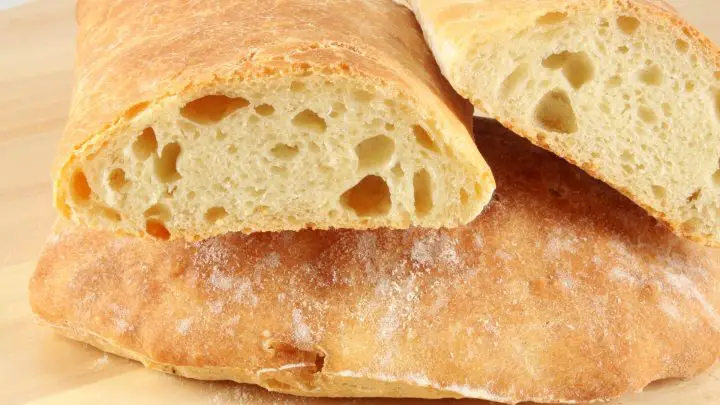
What To Serve With Sourdough Ciabatta?
There are many ways to enjoy this scrumptious Italian bread. Transforming a wet dough into a crisp and moist sourdough loaf with a delightful flavor is what we’re here to help you achieve!
Here are a few ways to consider serving your sourdough ciabatta bread.
- With extra virgin olive oil and balsamic vinegar: The simplest way to enjoy your sourdough ciabatta, is with a drizzle of olive oil and a sprinkle of balsamic vinegar. Simply slice your ciabatta roll into thick slices, and heat them for a couple of minutes to get them nice and crispy. Serve alongside a small bowl of olive oil and balsamic vinegar. Add a dash of extra flavor with chili flakes, basil, oregano, or garlic.
- With soup: The best thing about any type of sourdough bread, is that it’s so good at soaking up the golden flavors found in various soups. Whether it’s meaty, vegetable, or plain hot and spicy, sourdough won’t disappoint. This is why sourdough ciabatta makes the perfect dunking tool. To remain within the Italian theme, serve slices of warmed sourdough ciabatta with a thick tomato-based soup. For extra deliciousness, cut your ciabatta into cubes and enjoy it as an addition to your sweet and tangy soup!
- As an Italian sandwich: Since we’ll be using rolls, slice them in half, and add salami, mozzarella, turkey bacon, jalapenos, ham, red peppers, and pesto.
- Make a panini: Another great way to enjoy your ciabatta bread is to serve them as a grilled panini. Layer your ciabatta with your choice of meats, cheeses, and have them pressed against a grill. Serve with your favorite sauce for a delightful treat.
- As burger buns: Substitute regular burger buns for sourdough ciabatta rolls. Spread them with mayo, a meat or veggie patty, slices of tomatoes, and lettuce, and top with your favorite sauce. (I also have a sourdough burger buns recipe on my blog!)
- With stews: Enjoy a divine meat and vegetable stew with your freshly baked ciabatta as your side. These make the perfect tool for soaking up all that gorgeous flavor.
- As garlic bread: Brush slices of sourdough with some melted butter or olive oil. Spread some roasted or minced garlic on top and toast this in the oven for 5-10 minutes.
- Chopped and served as croutons: Any leftover ciabatta has a place in a refreshing salad bowl. Simply chop or tear your stale bread, and bake them for a couple of minutes until they’re crisp and golden. Serve atop a salad, drizzled with olive oil, oregano, and a pinch of minced garlic.
Sourdough Ciabatta Recipe to Try Now
Always use a mature starter for sourdough recipes. The best part is, you’ll always have some remaining for more sourdough recipes!
FAQs
Is Ciabatta Sourdough Healthy?
Yes, it is. When consumed in moderation, and paired with healthy foods, ciabatta provides many health benefits. In fact, it contains essential nutrients, minerals, and vitamins.
What Makes Ciabatta Bread Different?
Ciabatta bread provides a delicate, sweet taste compared to regular loaves of bread. Ciabatta dough has very high hydration levels, resulting in larger holes in the baked loaf.
What Does Ciabatta Bread Taste Like?
Ciabatta has a distinct sweet and savory taste.
How Would You Describe Ciabatta Bread?
Ciabatta has a golden crisp crust, coupled with a large open crumb.

